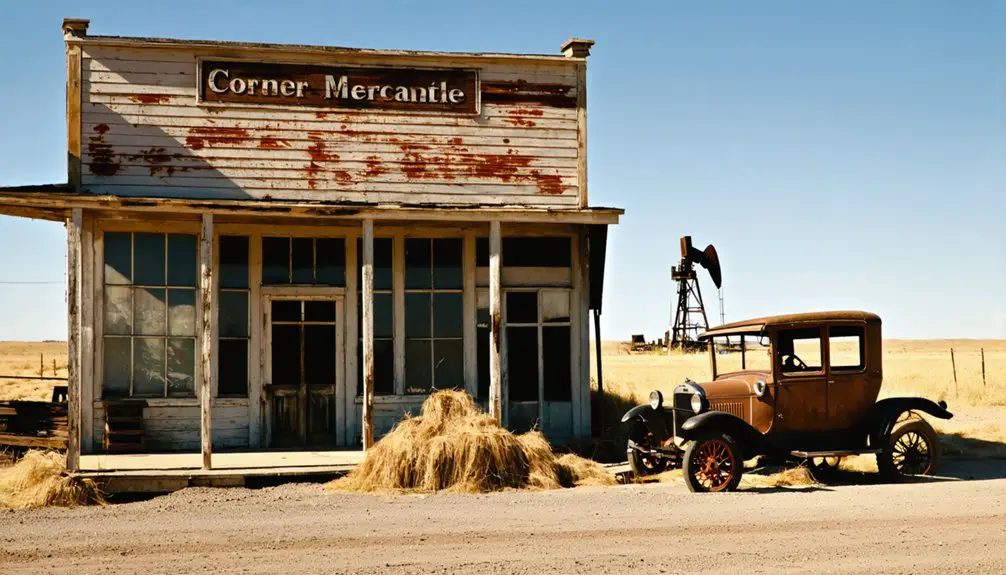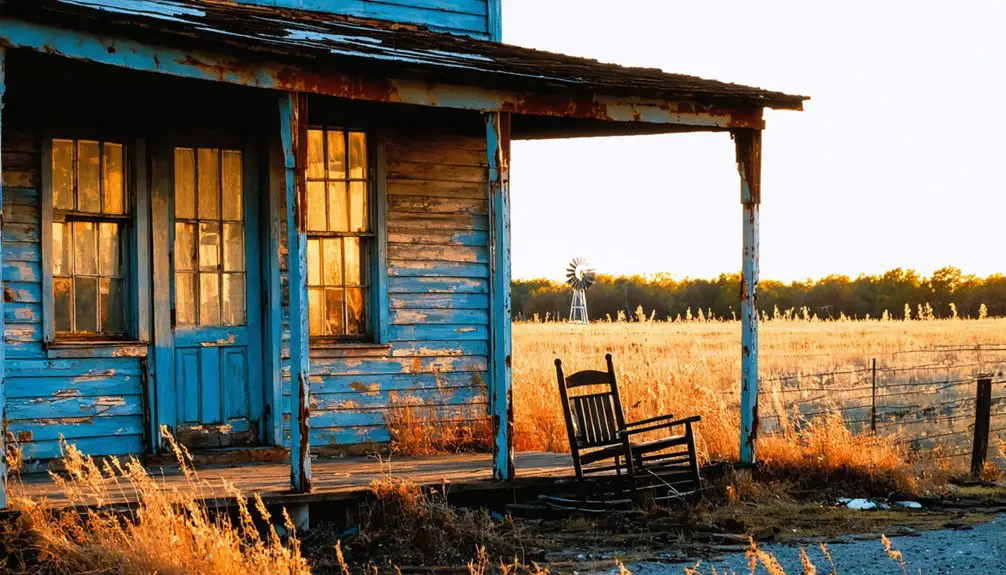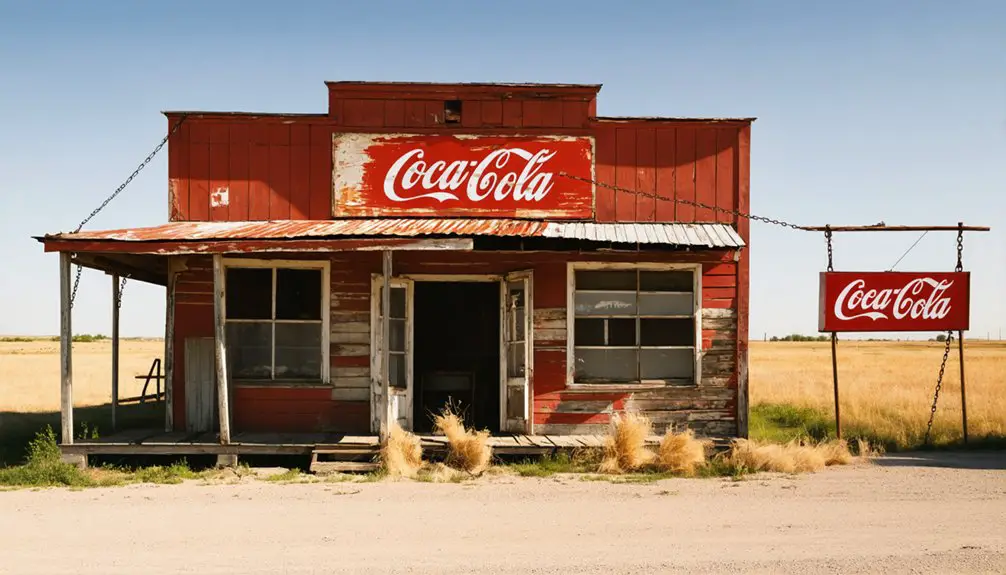You’ll find Corner’s ghost town origins in the 1890s along Oklahoma’s Indian Territory Line, where Bill Corner established a strategic settlement that quickly became a bustling trade hub. The town gained notoriety for its thriving liquor trade and as a haven for outlaws like the Doolin-Dalton Gang. When Oklahoma achieved statehood in 1907, prohibition laws triggered Corner’s dramatic decline, leading to an 80% population drop. The town’s fascinating tale of boom-and-bust reveals much about frontier life’s complexities.
Key Takeaways
- Corner, Oklahoma transformed from a thriving frontier settlement to a ghost town after statehood in 1907 caused prohibition laws.
- The town lost over 80% of its population when its lucrative liquor trade became illegal under Oklahoma state law.
- Originally established in the 1890s, Corner was a notorious outlaw haven and hub for alcohol distribution.
- The community featured essential frontier structures including a one-room schoolhouse, church, and trading posts.
- Local businesses and families abandoned the settlement when the economic framework collapsed due to statewide prohibition.
The Birth of a Border Town
While the Red River carved Oklahoma’s contentious southern border, Corner emerged as a proof of the region’s complex territorial evolution.
You’ll find its origins deeply rooted in the aftermath of border disputes between Texas and the federal government, particularly following the 1846 territorial changes that transformed the area.
As cultural assimilation policies pushed Native tribes into allotments, Corner’s strategic location near county boundaries and the Oklahoma-Texas border made it a natural hub for diverse settlers.
You’ll trace its foundations to the early 1890s when homesteaders, including German and Russian immigrants, claimed land after federal surveys. Seven counties were initially established when Oklahoma Territory was organized in 1890.
The arrival of the Rock Island railroad enhanced Corner’s significance, turning it into a crucial link for trade routes and cattle drives along the Great Western Trail. The region’s transformation into a major ranching center began when John Lytle established this vital cattle route in 1874.
Bill Corner’s Vision and Settlement
Three bold decisions shaped Bill Corner’s pioneering vision for his Oklahoma settlement. You’ll recognize his strategic genius in choosing land near expanding railroad routes, establishing plots for both residential and commercial growth, and implementing settlement strategies that attracted diverse settlers, from farmers to skilled traders.
Corner’s community leadership shone through his emphasis on building essential infrastructure and social institutions. He’d fostered a spirit of cooperation among settlers, encouraging their participation in local governance while tackling the harsh realities of frontier life. The region’s history as a criminal hideout made establishing law and order a top priority.
You can trace his influence in how he organized the community to pool resources and share responsibilities, creating a foundation for sustainable growth. His vision capitalized on the Land Run of 1889 opportunities, transforming unassigned territory into a self-sustaining town built on agriculture and trade. Like thousands of other settlers seeking opportunity, Corner raced to claim his parcel during this pivotal moment in westward expansion.
Life Along the Indian Territory Line
You’ll find that law enforcement along the Indian Territory line faced constant challenges, with federal marshals and tribal police struggling to control illegal trade and border crossings near Corner.
The suzerain tribal nations maintained their own systems of governance and law enforcement within the territory, adding another layer of complexity to border relations. Local traders established complex networks that crossed territorial boundaries, connecting Corner’s merchants with both Native American communities and white settlers.
The mixing of legal and illicit commerce created a dynamic but often tense atmosphere, as authorities worked to regulate everything from cattle drives to merchandise sales across the territorial divide. Since federal and tribal authorities held primary jurisdiction over Indians in the territory, state law enforcement had limited power to intervene in matters involving Native American traders.
Border Law Enforcement Challenges
Despite the complex nature of law enforcement along Indian Territory’s boundaries, tribal police forces played a significant role in maintaining order during the late 1800s.
You’ll find that border enforcement often required exceptional cooperation between tribal officers and federal authorities to combat crime effectively. Jurisdictional conflicts arose frequently along the territorial line, where criminals attempted to exploit gaps in authority.
- Tribal police operated from their homes, giving them essential local knowledge for tracking criminals across borders.
- Cross-deputization agreements helped bridge authority gaps between tribal and state law enforcement.
- Officers needed expertise in both local terrain and community relationships to pursue fugitives.
- The boundary line became a hotspot for smuggling and illegal alcohol trade, requiring coordinated enforcement efforts.
Cross-Territory Trade Networks
While the Indian Territory Line marked a political boundary, it served as a vibrant hub of cross-cultural commerce where complex trade networks flourished among the Five Civilized Tribes and surrounding populations.
You’d find established trade routes connecting the Plains, Southwest, and Pacific Coast, with goods moving through multiple tribes who each added significant markups. Tribes commonly applied 100 percent markups when trading valuable goods with other tribes.
At trading posts and rendezvous sites, you could witness the exchange of cotton from Choctaw plantations, cattle, salt, and pottery alongside imported items like seashells and copper. Fort Gibson soldiers helped maintain peaceful trading conditions along the Arkansas River.
The commodity exchange wasn’t just about goods – it fostered political alliances and social relationships between displaced tribes.
Whether you were Cherokee trading horses or Caddo exchanging traditional tools, you’d participate in a sophisticated network that reflected both indigenous traditions and new European influences in the territory.
The Booming Liquor Trade Era
You’ll find Corner’s most profitable period centered around its thriving liquor trade, which exploited the town’s strategic position along the Indian Territory border where alcohol was prohibited.
Bill Corner founded the frontier outpost in 1892, establishing what would become a notorious hub for alcohol distribution.
The town’s relaxed law enforcement and challenging terrain made it an attractive haven for outlaws like the Dalton Gang, who contributed to the area’s dangerous reputation.
Your mental picture of Corner during this era should include a bustling mix of legitimate alcohol merchants and shadowy characters, all profiting from the steady stream of customers crossing territorial lines to purchase otherwise restricted liquor.
Like many liquor towns, Corner emerged as one of thousands of settlements that flourished by serving alcohol to residents from neighboring dry territories.
Border Town Beer Business
During Oklahoma Territory’s pre-statehood years from 1890 to 1907, Corner emerged as a pivotal hub for the region’s booming liquor trade.
Located strategically in southeastern Pottawatomie County near the Indian Territory border, Corner’s position made it perfect for border trade and liquor smuggling operations. You’d find thriving saloons drawing outlaws, ranch hands, and traders who capitalized on the high demand for alcohol in the neighboring dry territory.
- Cowboys pioneered “bootlegging” by hiding liquor in their boots while crossing borders
- Local saloons attracted notorious gangs like the Bill Doolin gang and Black Wyatt
- The sparse law enforcement and ambiguous border territories created ideal smuggling conditions
- Profits from illegal alcohol sales outpaced legitimate commerce, driving Corner’s economic boom
Outlaw Haven Profits Rise
As Corner’s reputation for lawlessness grew throughout the 1890s, the town transformed into a lucrative safe haven for outlaws and bootleggers alike.
You’d find notorious criminals like the Dalton Gang operating freely in the area, where law enforcement dared not venture due to the overwhelming presence of armed outlaws.
The outlaw economy thrived on strategic geography – Corner’s position near Indian Territory’s borders made it perfect for bootlegging networks to distribute alcohol to the “dry” nations.
Without effective fencing or proper policing, bootleggers ran their operations with impunity, establishing a robust underground market.
The profits were immense, supporting not just the illegal liquor trade but also legitimate businesses like saloons, groceries, and lodging that catered to those seeking alcohol outside prohibition boundaries.
Outlaws and Lawlessness

While most frontier towns experienced their share of criminal activity, Corner, Oklahoma became a notorious haven for some of the West’s most dangerous outlaws in the 1890s.
The infamous Doolin-Dalton Gang used the area as their hideout, bringing outlaw culture and gang violence to the region. You’d find hardened criminals like Bill Doolin and “Tulsa Jack” Blake conducting brazen bank robberies and engaging in deadly shootouts with law enforcement.
Notorious outlaws like the Doolin-Dalton Gang terrorized Corner, robbing banks and battling lawmen in violent shootouts across Oklahoma Territory.
- The Battle of Ingalls left multiple casualties among outlaws and citizens.
- Corrupt officials worked with criminals in fraudulent land deals.
- Revenge killings and hired murders by figures like “Deacon” Jim Miller were common.
- Local merchants profited from the lawlessness, tolerating outlaws for their economic influence.
Daily Life in a Frontier Haven
Beyond the gunsmoke and outlaw chaos, Corner’s daily existence painted a different picture of frontier life. You’d find residents working the land, tending livestock, and bartering at the general store for essential supplies.
Frontier survival meant adapting to rough wooden housing and drawing water from wells, while community resilience showed in the way neighbors supported each other through harsh seasons and economic uncertainties.
Your days would revolve around the rhythms of agricultural work, with the one-room schoolhouse and church serving as social anchors. You’d rely on horse-drawn wagons for transportation and enthusiastically await mail delivery for news from the outside world.
When challenges struck – whether drought, illness, or economic downturn – you’d band together with fellow townspeople, embodying the cooperative spirit that defined frontier living.
The Impact of Oklahoma Statehood

When Oklahoma achieved statehood in 1907, Corner faced dramatic changes that would ultimately seal its fate. The newly enacted prohibition laws struck at the heart of the town’s economic foundation, triggering a swift economic decline as its once-thriving liquor trade became illegal overnight.
Cultural shifts followed as residents, faced with dwindling opportunities, began seeking prospects elsewhere.
- You’d have witnessed mass exodus as the population dropped over 80%, meeting ghost town criteria.
- Your town’s autonomy vanished as state authorities enforced strict new regulations.
- Local business owners couldn’t adapt as the economic framework altered dramatically.
- Your community’s social fabric unraveled as families relocated to larger towns with schools and churches.
The change stripped Corner of its frontier identity, though its legacy lives on through descendants who still honor their roots.
From Bustling Town to Abandoned Land
As Oklahoma’s statehood laws took effect in 1907, Corner’s transformation from a bustling frontier town to an abandoned ghost town accelerated dramatically.
The once-thriving liquor economy that had sustained the community came to an abrupt halt, forcing businesses to shutter and residents to seek opportunities elsewhere.
You would’ve witnessed a stark community decline as Corner lost 80% or more of its population.
Commercial buildings and homes stood empty as the town’s primary economic engine ground to a stop.
Without a diversified economy to fall back on, Corner couldn’t survive the prohibition laws that eliminated its core industry.
The pattern mirrored other liquor towns like Violet Springs and Keokuk Falls, which also faded into abandonment when their alcohol-based economies became illegal under statehood regulations.
Preserving Corner’s Historical Legacy

Today’s preservation efforts aim to protect what remains of Corner’s historical footprint. Community involvement through organizations like Preservation Oklahoma has helped document and advocate for this ghost town’s significance.
Local groups work tirelessly to preserve Corner’s historical legacy, documenting its ghostly remains for future generations to appreciate.
You’ll find preservation challenges including structural decay and vandalism that threaten the site’s remaining structures. Local historical societies and museums play essential roles in maintaining records and photographs that tell Corner’s story.
- Documentation projects capture oral histories from former residents and their descendants
- University collections preserve important records and photographs of Corner’s past
- Historical markers and interpretive signs help educate visitors about the town’s significance
- Social media groups and online initiatives enable sharing of historical findings and memories
Through these combined efforts, Corner’s legacy continues despite the physical deterioration of its buildings.
Frequently Asked Questions
Are There Any Remaining Structures or Ruins Visible in Corner Today?
You’ll find very few remaining buildings in Corner today, with evidence suggesting only scattered foundational ruins and historical artifacts remain visible across the former townsite’s landscape.
What Happened to Bill Corner After the Town’s Decline?
Like countless whispers in the wind, Bill’s legacy vanished into history. You won’t find records of what happened to Corner’s ghost after 1906 when prohibition killed his town’s spirit.
How Many Saloons Operated in Corner During Its Peak Years?
You’ll find at least two saloons operated during Corner’s peak years, with the Black Dog and Red Front Saloon running simultaneously. The saloons’ history shaped the town’s notorious whiskey reputation.
Did Native Americans From Nearby Nations Frequently Visit Corner?
Like texting old friends, Native Americans maintained cultural exchanges around Corner, visiting from nearby nations. Historical interactions show they’d travel through for trade, ceremonies, and traditional activities across Indian Territory.
Were There Any Notable Shootouts or Conflicts Between Law Enforcement and Outlaws?
You won’t find documented shootout history or major outlaw legends in Corner’s records, though the town’s remote location and whiskey trade likely saw unrecorded conflicts between lawmen and outlaws.
References
- https://www.geocaching.com/geocache/GC19D1N
- https://en.wikipedia.org/wiki/List_of_ghost_towns_in_Oklahoma
- https://nondoc.com/2022/01/04/whizbang-oklahoma-ghost-town/
- https://www.okhistory.org/publications/enc/entry?entry=GH002
- https://the405voyager.com/5-ghost-towns-in-oklahoma-that-will-give-you-the-creeps/
- https://www.okhistory.org/publications/enc/entry?entry=WA035
- https://en.wikipedia.org/wiki/Oklahoma_Territory
- https://www.kgou.org/oklahoma-news/2019-04-15/how-curious-where-is-oklahomas-southwest-corner
- https://en.wikipedia.org/wiki/Oklahoma_panhandle
- https://www.youtube.com/watch?v=7Eyo7jUralg



